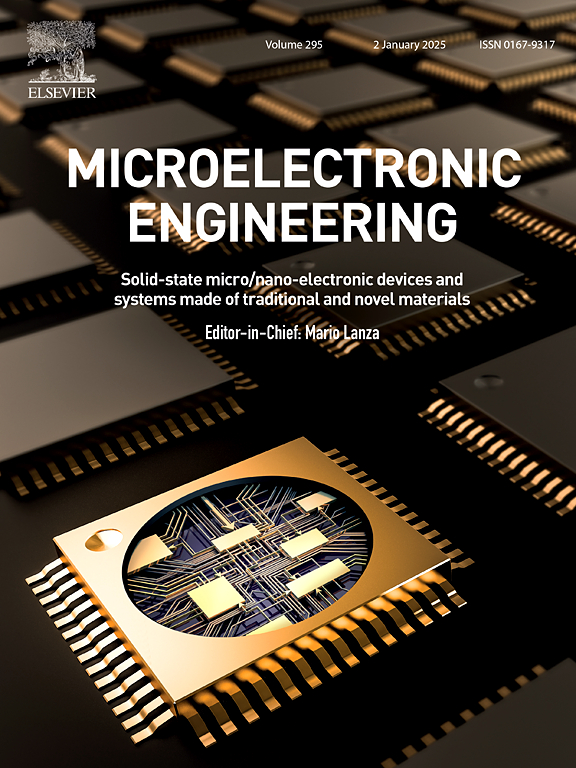A 0.324-THz transmitter based on individual 2.65 % efficiency x16 frequency multiplier chiplets for phased-array and PMF applications
IF 3.1
4区 工程技术
Q2 ENGINEERING, ELECTRICAL & ELECTRONIC
引用次数: 0
Abstract
A 0.324-THz multiplier-based (x16) transmitter with an on-chip patch antenna for application in phased arrays and plastic microwave fiber links has been implemented in a 130-nm SiGe:C bipolar CMOS technology with an of 350/450 GHz. The chiplet features integrated digitally programmable power management and biasing for post‑silicon optimization. Each radio frequency circuit block can be individually tuned by a bias current generator, and a total of three programmable voltage regulators supply the three bootstrapped doublers used from 20-to-160 GHz, the two-stage 160-GHz power amplifier and the 0.32-THz frequency doubler, respectively. After rigorous optimization, measurements reveal a single-chain dc-to-THz efficiency of 2.65 % with an output power up to 6.6 dBm at 0.324 THz. The dc power consumption was 170 mW. Operated in a 1-by-4 phased array, a maximum effective isotropic radiated power of 13.1 dBm with an output power of 2.9 dBm has been measured. Beam steering is demonstrated, revealing beam scanning over 22° in one plane. Used as a transmitter for plastic microwave fiber links, the on-chip antenna enables contactless coupling to the fiber, showing overall significantly reduced path losses compared to over-the-air links. A close-to-real-world demonstration of a PMF link with up to 3.25 Gbit/s using QPSK modulation is presented, using separate unsynchronized transmitter and receiver LO signal sources.

基于单个2.65%效率x16倍频芯片的0.324 thz发射机,用于相控阵和PMF应用
一种基于0.324 thz乘法器的(x16)发射机,带有片上贴片天线,适用于相控阵和塑料微波光纤链路,采用130 nm SiGe:C双极CMOS技术,fT/fmax为350/450 GHz。该芯片具有集成的数字可编程电源管理和后硅优化的偏置。每个射频电路模块都可以由一个偏置电流发生器单独调谐,总共有三个可编程稳压器分别提供20至160 GHz的三个自启动倍频器、两级160 GHz功率放大器和0.32太赫兹倍频器。经过严格的优化,测量结果显示单链dc-to-THz效率为2.65%,在0.324 THz时输出功率高达6.6 dBm。直流功耗为170 mW。在1 × 4相控阵中,测量到最大有效各向同性辐射功率为13.1 dBm,输出功率为2.9 dBm。演示了光束转向,在一个平面上显示了22°以上的光束扫描。作为塑料微波光纤链路的发射器,片上天线可以实现与光纤的非接触式耦合,与空中链路相比,总体上显着降低了路径损耗。本文给出了一个接近真实世界的PMF链路演示,该链路使用QPSK调制,使用单独的不同步发送端和接收端LO信号源,传输速率高达3.25 Gbit/s。
本文章由计算机程序翻译,如有差异,请以英文原文为准。
求助全文
约1分钟内获得全文
求助全文
来源期刊

Microelectronic Engineering
工程技术-工程:电子与电气
CiteScore
5.30
自引率
4.30%
发文量
131
审稿时长
29 days
期刊介绍:
Microelectronic Engineering is the premier nanoprocessing, and nanotechnology journal focusing on fabrication of electronic, photonic, bioelectronic, electromechanic and fluidic devices and systems, and their applications in the broad areas of electronics, photonics, energy, life sciences, and environment. It covers also the expanding interdisciplinary field of "more than Moore" and "beyond Moore" integrated nanoelectronics / photonics and micro-/nano-/bio-systems. Through its unique mixture of peer-reviewed articles, reviews, accelerated publications, short and Technical notes, and the latest research news on key developments, Microelectronic Engineering provides comprehensive coverage of this exciting, interdisciplinary and dynamic new field for researchers in academia and professionals in industry.
 求助内容:
求助内容: 应助结果提醒方式:
应助结果提醒方式:


